A Journey to Escape the Heat:
A 2013 Summer Trip through Finland, Sweden, Norway, and Denmark
This travelogue was updated in 2020. Please note that operating hours can vary depending on the season and that there may be regular closure days as well as closures on specific holidays such as Christmas, Epiphany, and New Year's Day. Therefore, when planning your schedule, be sure to check Google Maps or the official websites directly.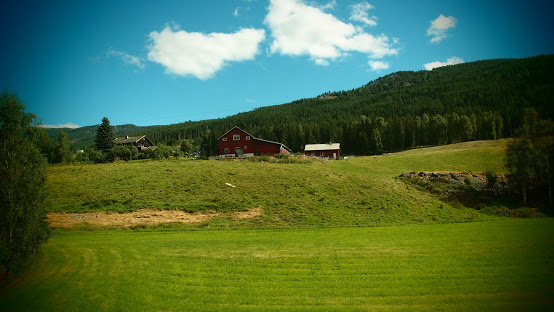
We packed only part of our luggage for the trip to Bergen since we would be heading to Oslo again after the tour and staying for another night. We left the rest of our belongings at the hotel, which kindly agreed to store them. Thanks for kind hotel staff.
The journey to Bergen took about six hours, which is not a short trip, but the stunning natural scenery provided visual refreshment and peace of mind during the travel. Although it was peak season in Northern Europe, the train was not crowded. However, since this route is quite popular, it is advisable to book tickets in advance rather than purchasing them on the day of travel.
It's hard to believe even when you see it with your own eyes. Despite not being at the top of a mountain, the midday temperature in early August was 12 degrees Celsius. It is definitely a place where long sleeves are necessary. Although Bergen is not much further north than Oslo, the temperature difference is quite significant.
While our stay in Bergen was less than 24 hours, there were several places we wanted to visit, so we purchased a Bergen Card. For more information about the Bergen Card, check the link below!Bergen City Card Official Website
Bergen, built by Olaf III in 1070, served as the capital of Norway during the 12th and 13th centuries and was the site of the first royal coronation.As Norway's second-largest city and its largest port city, Bergen is nestled between high mountains and the fjord coastline. Upon entering the city center, you can see medieval features preserved in the wooden houses, wharfs, open-air fish market, and colonnaded shops lining the cobblestone streets. Among these, the Bryggen district, which once belonged to the Norwegian aristocracy that monopolized foreign trade, was the largest trading port in the medieval Scandinavian Peninsula.
— Excerpt from UNESCO World Cultural Heritage (National Geographic Teachers' Association)
We arrived in Bergen. Due to a tighter-than-expected schedule, we stored our luggage in the coin lockers at Bergen station and carefully kept the receipt before starting our itinerary. Fortunately, the tourist attractions were clustered together, making it easy to move around on foot. Bergen is the second-largest city in Norway after Oslo, with a population of 270,000. Established in 1070, it was once the capital city and the largest trade city in Northern Europe. In the 1270s, German merchants settled here and remained until the dissolution of the Hanseatic League in 1784. They resided in the Bryggen district, which is now designated as a UNESCO World Heritage Site.
Bergen's major exports were seafood, while its imports were grains. Surrounded by many mountains, Bergen is known as the city nestled among seven mountains. The highest of these, Mount Ulriken, can be reached by cable car.
Today, Bergen has transitioned into a hub for maritime shipping, the petroleum industry, aquaculture, and food processing, rather than solely focusing on trade. It also boasts several museums and art galleries. Additionally, as the gateway city to the fjords, Bergen serves as both the starting point and the endpoint for all tours related to the fjords.
The port city of Bergen, located in northern Norway, was once a thriving member of the Hanseatic League, flourishing with dried cod and timber exports. Bryggen, a term referring to the port area, was predominantly owned by German merchants who engaged in vigorous trade with various cities in Northeastern Europe, centered around Lübeck.
Bryggen, being a harbor area, is lined with docks where ships are often moored. The buildings, typically 4-5 stories high with steeply pitched gabled roofs, lean towards the docks. These buildings house shops, mostly selling furs and souvenirs. Stuffed heads of deer or reindeer are often displayed on the signboards to attract attention.
The museum, converted from an office used during the time of the Hanseatic League, showcases equipment used on ships, trade goods, ledgers, and penalty boxes installed to monitor sailors. The guide mentioned that wooden structures are vulnerable to fire, and many buildings in this area were reconstructed multiple times after being destroyed by fires. Therefore, he emphasized no smoking repeatedly. Thanks to such efforts, I couldn't help but wonder if it's because of these endeavors that Bryggen has remained as a district of wooden houses to this day.
— Excerpt from "UNESCO World Cultural Heritage" by Kwon
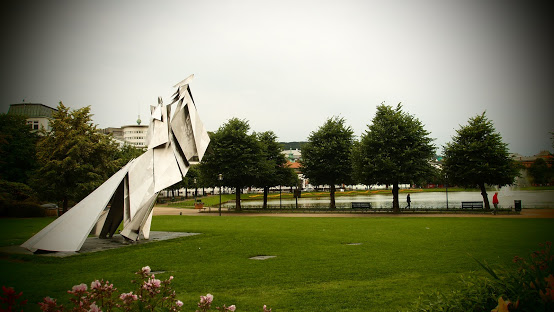
The park surrounding the lake is incredibly spacious. There's even a piano, and people often play it. I've seen pianos in squares before, but it's the first time I've seen one in a vast park with grassy lawns. Not only pianos, but there are also various other musical instruments, which children seem to enjoy playing.
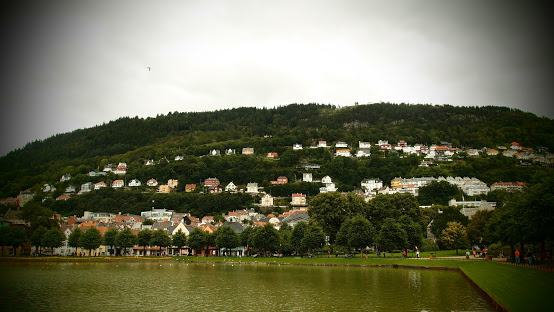
@Lille lungegardsvannet; Artificial Lake
You can often see many people strolling around the lake, and nearby, museums and art galleries are densely clustered. The park around the lake is well-designed, with various sculptures on display. I'm curious about the message behind the statue of a crying baby in the fountain. 😊
(Here's something I learned later: Norway has a famous sculptor named Gustav Vigeland. Vigeland Park, which houses Vigeland's sculptures, is also a famous tourist destination. The crying baby statue is said to be a replica of one of Vigeland's famous works.)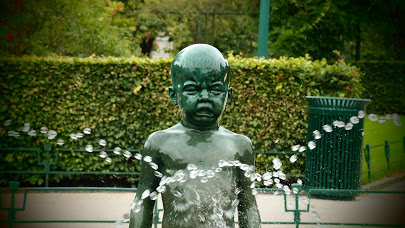
@Julemarked byparken
On the other side of the lake, there's a small park with a gazebo where I also spotted people taking walks or doing exercises. I saw some young friends practicing quite challenging movements. I wonder if they're preparing for a physical education performance or perhaps they're members of a cheerleading club at school.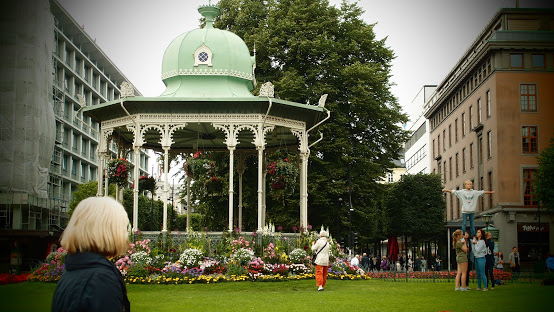
@KODE
Open_10:00~17:00 (Winter 11:00~16:00, Weekend ~17:00 / KODE 1~4 are same)
Winter, KODE 1, Tuesday 11:00~20:00
Closed_ Monday
Fee_ Winter 130 NOK, Summer 160 NOK (Free admission October–April, 25% discount May–September)
While walking around the lake, I came across several buildings arranged like an estate, which appeared to be an art museum. Upon entering, I found out it was a place I could visit with a pass ticket. I didn't have any special expectations since I had entered the museum by chance while strolling through the park. However, there were many works by famous artists, so it felt like discovering pearls in the mud.
(I wrote "pass ticket" above, but I'm not exactly sure if it was the Eurail Pass or the Bergen Card.)
I didn't have much time to explore leisurely as I hadn't allotted enough time before closing. The museum consisted of not just one building but several, forming an art museum complex. When entering for the first time, I received a sticker to put on my clothes, and from then on, I could freely enter other buildings without separate ticket checks. Since the buildings were lined up along the lake, it wasn't difficult to visit them.
- Bergen kunst hall : Artworks by artists from various countries.
- KODE3 KODE 3 : A collection of works by Munch.
- KODE4 KODE 4 : Artworks by Norwegian artists

댓글
댓글 쓰기